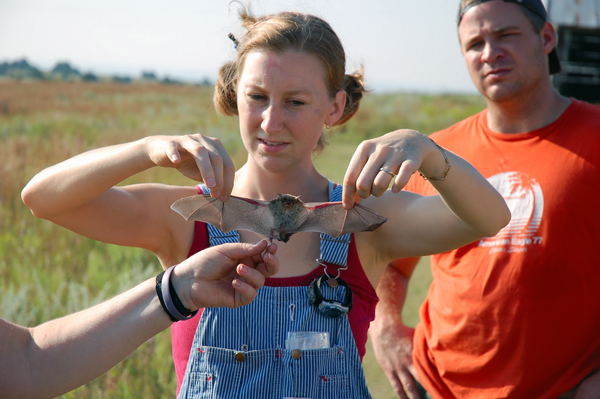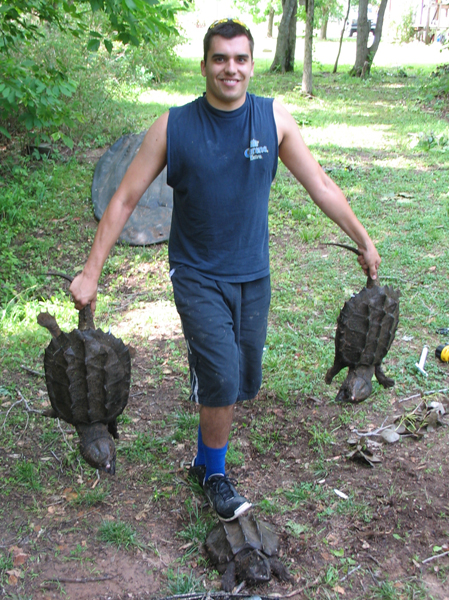 The start of the OSU COV can be traced to a natural history collection made in 1932 by George A. Moore and his field biology class. This collection comprised ichthyological and herpetological specimens from Oklahoma and adjacent states. Specimens donated by other institutions, most notably the University of Michigan Museum of Zoology, supplemented Moore’s material. By 1940, the collection had grown to approximately 900 catalogued lots. Much of the early material in the Collection of Fishes came from the Illinois River Survey conducted by Moore and J. M. Paden. Additional material contributed by Dr. Carl Hubbs, then at University of Michigan Museum of Zoology, expanded representation of non-Oklahoma fishes.
The start of the OSU COV can be traced to a natural history collection made in 1932 by George A. Moore and his field biology class. This collection comprised ichthyological and herpetological specimens from Oklahoma and adjacent states. Specimens donated by other institutions, most notably the University of Michigan Museum of Zoology, supplemented Moore’s material. By 1940, the collection had grown to approximately 900 catalogued lots. Much of the early material in the Collection of Fishes came from the Illinois River Survey conducted by Moore and J. M. Paden. Additional material contributed by Dr. Carl Hubbs, then at University of Michigan Museum of Zoology, expanded representation of non-Oklahoma fishes.
Beginning in 1930, Dr. George Moore undertook much of the early work in the Collection of Amphibians and Reptiles. Dr. Bryan P. Glass expanded holdings by collecting and trading for specimens from around the world in the mid 20th century. Dr. Milton Curd arrived in 1964 and, along with Dr. Moore, continued to document Oklahoma amphibians and reptiles, including the first specimen of amphiuma (Amphiuma tridactylum) in Oklahoma. C. J. McCoy, then an OSU graduate student, worked to strengthen the collection’s holdings of specimens from Oklahoma and Texas and traded for specimens from the southwestern U.S., principally Arizona. After becoming Curator of Reptiles and Amphibians at Carnegie Museum of Natural History, Dr. McCoy continued to trade specimens with OSU.
The first bird donated to the OSU COV was prepared in 1923. Most of the earlier collections had little data, and many specimens were taxidermy mounts. Although Dr. Glass and his students added specimens to the Collection of Birds, it has not grown as much as other collections. Along with taxidermy mounts and study skins, there are small collections of waterfowl wings, nests, and approximately 300 eggs that date to the late 1800s.
 The first specimen cataloged into the OSU COV Collection of Mammals was a Peromyscus leucopus collected in Michigan in 1924. The Collection of Mammals remained a relatively small collection for the first 25 years. Upon his arrival as Curator of Vertebrates in 1947, Dr. Bryan P. Glass took special interest in the Collection of Mammals and instituted a vigorous program to expand the collection to be both geographically and taxonomically diverse. Between 1947 and 1985, Glass expanded the Collection of Mammals from a small regional holding to a Collection of international significance. Through the collecting efforts of Dr. Glass and his students, and through trade with other museums, the Collection of Mammals is one of the most diverse collections at any university. It includes representatives of Monotremata, Metatheria, and all eutherian orders and has sizable holdings of osteological material for Sirenia and Odontoceti.
The first specimen cataloged into the OSU COV Collection of Mammals was a Peromyscus leucopus collected in Michigan in 1924. The Collection of Mammals remained a relatively small collection for the first 25 years. Upon his arrival as Curator of Vertebrates in 1947, Dr. Bryan P. Glass took special interest in the Collection of Mammals and instituted a vigorous program to expand the collection to be both geographically and taxonomically diverse. Between 1947 and 1985, Glass expanded the Collection of Mammals from a small regional holding to a Collection of international significance. Through the collecting efforts of Dr. Glass and his students, and through trade with other museums, the Collection of Mammals is one of the most diverse collections at any university. It includes representatives of Monotremata, Metatheria, and all eutherian orders and has sizable holdings of osteological material for Sirenia and Odontoceti.
The Collection of Vertebrates currently houses specimens of fishes, amphibians, reptiles, birds, mammals, and frozen tissues for use in research, teaching, and extension. The collection contains several types of preparations, including fluid-preserved specimens, skins, tanned hides, taxidermy mounts, osteological material, cleared and stained specimens, karyological slides, and frozen tissues. Other resources of the Collection include a catalogued library of reprints, maps, and collectors' field notes and catalogues.
